Preparation and In Vitro Bioactivity Study of a Novel Hollow Mesoporous Bioactive Glass Nanofiber Scaffold
Abstract
1. Introduction
2. Results
2.1. Synthesis of Hollow Mesoporous MBG Nanofiber Scaffold
2.2. Physicochemical Properties of the MBG Nanofiber Scaffold
3. Discussion
3.1. Formation Mechanism of Hollow MBG Nanofiber Scaffold
3.2. In Vitro Bioactivity of the MBG Nanofiber Scaffold
3.3. Cellular Responses to MBG Scaffold
4. Materials and Methods
4.1. Materials and Chemical
4.2. Preparation of MBG Nanofiber Scaffold
- (1)
- First, 4 g of P123 was added to 50 mL of anhydrous ethanol and stirred until completely dissolved. To this solution, we successively added 9 mL of tetraethyl orthosilicate (TEOS), 1.75 g of calcium nitrate (CN), and 1 mL of triethyl phosphate (TEP). The obtained mixed solution was thoroughly stirred until it became uniform. Next, 25 mg of BC aerogel was soaked in this solution for 24 h. Once removed, the BC aerogel was washed twice quickly with ethanol and stored for later use.
- (2)
- Second, 5 mL of H2O and 45 mL of anhydrous ethanol were combined and stirred to form an evenly mixed solution. The aerogel sample prepared in Step (1) was immersed in this solution for 24 h to complete hydrolysis and polycondensation. The obtained sample was freeze-dried to afford a SiO2/CaO/P2O5@BC hybrid material, which was then placed in a tubular furnace and heated from room temperature to 300 °C at 1 °C/min. After 30 min holding at 300 °C, the sample was heated to 600 °C and held at that temperature for 5 h, affording the targeted 3D hollow MBG nanofiber scaffold.
4.3. Characterization of MBG Nanofiber Scaffold
4.4. In Vitro Bioactivity Experiment of the MBG Nanofiber Scaffold
4.5. Cell Study
5. Conclusions
Author Contributions
Funding
Institutional Review Board Statement
Informed Consent Statement
Data Availability Statement
Acknowledgments
Conflicts of Interest
Sample Availability
References
- Tang, W.; Lin, D.; Yu, Y.; Niu, H.; Guo, H.; Yuan, Y.; Liu, C. Bioinspired trimodal macro/micro/nano-porous scaffolds loading rhBMP-2 for complete regeneration of critical size bone defect. Acta Biomater. 2016, 32, 309–323. [Google Scholar] [CrossRef]
- Zhang, Y.; Xia, L.; Zhai, D.; Shi, M.; Luo, Y.; Feng, C.; Fang, B.; Yin, J.; Chang, J.; Wu, C. Mesoporous bioactive glass nanolayer-functionalized 3D-printed scaffolds for accelerating osteogenesis and angiogenesis. Nanoscale 2015, 7, 19207–19221. [Google Scholar] [CrossRef]
- Xiao, J.; Wei, Q.; Xue, J.; Liu, Z.; Li, Z.; Zhou, Z.; Chen, F.; Zhao, F. Mesoporous bioactive glass/bacterial cellulose composite scaffolds for bone support materials. Colloids Surf. A 2022, 642, 128693. [Google Scholar] [CrossRef]
- Huang, X.H.; Yan, X.X.; Han, L.; Yi, J.; Lei, J.; Zhao, D.Y.; Yu, C.Z. Influence of the dosage of mesoporous bioactive glass in simulated body fluid on the in vitro bioactivity evaluation. Acta Chim. Sin. 2006, 64, 851–857. [Google Scholar]
- Li, N.; Jie, Q.; Li, Q.; Wang, R.D. Preparation and characterization of monolithic sol-gel bioactive glass. Acta Chim. Sin. 2004, 62, 1533–1538. [Google Scholar]
- Zhou, Z.; Liu, L.; Liu, Q.; Huang, T.; Zeng, W.; Yi, Q.; Yang, Z.; Cao, D. Evaluation of Biological Properties In-Vivo of Poly(L-Lactide-Coglycolide) Composites Containing Bioactive Glass. Polym. Polym. Compos. 2013, 21, 79–84. [Google Scholar] [CrossRef]
- Bai, X.; Liu, W.; Xu, L.; Ye, Q.; Zhou, H.; Berg, C.; Yuan, H.; Li, J.; Xia, W. Sequential macrophage transition facilitates endogenous bone regeneration induced by Zn-doped porous microcrystalline bioactive glass. J. Mater. Chem. B 2021, 9, 2885–2898. [Google Scholar] [CrossRef] [PubMed]
- Zhou, Z.H.; Cao, D.F.; Huang, T.L.; Liu, L.L.; Liu, Q.Q.; Zhao, Y.M.; Ou, B.L.; Zeng, W.N.; Xu, G.R.; Tang, A.P.; et al. Fabrication and characterisation of gelatin-hyaluronic acid/nanobioactive glass hybrid scaffolds for tissue engineering. Mater. Res. Innov. 2013, 17, 532–536. [Google Scholar] [CrossRef]
- Yan, X.; Yu, C.; Zhou, X.; Tang, J.; Zhao, D. Highly ordered mesoporous bioactive glasses with superior in vitro bone-forming bioactivity. Angew. Chem. Int. Ed. Engl. 2004, 43, 5980–5984. [Google Scholar] [CrossRef] [PubMed]
- Chan, M.H.; Lin, H.M. Preparation and identification of multifunctional mesoporous silica nanoparticles for in vitro and in vivo dual-mode imaging, theranostics, and targeted tracking. Biomaterials 2015, 46, 149–158. [Google Scholar] [CrossRef] [PubMed]
- El-Fiqi, A.; Kim, T.H.; Eltohamy, M.; Won, J.E.; Lee, E.J.; Kim, H.W. Capacity of mesoporous bioactive glass nanoparticles to deliver therapeutic molecules. Nanoscale 2012, 4, 7475–7488. [Google Scholar] [CrossRef] [PubMed]
- Taherkhani, S.; Moztarzadeh, F. Influence of strontium on the structure and biological properties of sol-gel-derived mesoporous bioactive glass (MBG) powder. J. Sol-Gel Sci. Technol. 2016, 78, 539–549. [Google Scholar] [CrossRef]
- Young, J.L.; Holle, A.W.; Spatz, J.P. Nanoscale and mechanical properties of the physiological cell–ECM microenvironment. Exp. Cell Res. 2016, 343, 3–6. [Google Scholar] [CrossRef] [PubMed]
- Greiner, A.; Wendorff, J.H. Electrospinning: A fascinating method for the preparation of ultrathin fibers. Angew. Chem. Int. Ed. 2007, 46, 5670–5703. [Google Scholar] [CrossRef] [PubMed]
- Deliormanll, A.M. Preparation and in vitro characterization of electrospun 45S5 bioactive glass nanofibers. Ceram. Int. 2015, 41, 417–425. [Google Scholar] [CrossRef]
- Bäckdahl, H.; Helenius, G.; Bodin, A.; Nannmark, U.; Johansson, B.R.; Risberg, B.; Gatenholm, P. Mechanical properties of bacterial cellulose and interactions with smooth muscle cells. Biomaterials 2006, 27, 2141–2149. [Google Scholar] [CrossRef] [PubMed]
- Quintero, F.; Pou, J.; Comesaña, R.; Lusquiños, F.; Riveiro, A.; Mann, A.B.; Hill, R.G.; Wu, Z.Y.; Jones, J.R. Laser spinning of bioactive glass nanofibers. Adv. Funct. Mater. 2009, 19, 3084–3090. [Google Scholar] [CrossRef]
- Hong, Y.; Chen, X.; Jing, X.; Fan, H.; Guo, B.; Gu, Z.; Zhang, X. Preparation, Bioactivity, and Drug Release of Hierarchical Nanoporous Bioactive Glass Ultrathin Fibers. Adv. Mater. 2010, 22, 754–758. [Google Scholar] [CrossRef]
- Khan, M.U.S.; Razak, S.I.A.; Rehman, S.; Hasan, A.; Qureshi, S.; Stojanović, G.M. Bioactive scaffold (sodium alginate)-g-(nHAp@SiO2@GO) for bone tissue engineering. Int. J. Biol. Macromol. 2022, 222, 462–472. [Google Scholar] [CrossRef]
- Barud, H.S.; Assunção, R.M.N.; Martines, M.A.U.; Dexpert-Ghys, J.; Marques, R.F.C.; Messaddeq, Y.; Ribeiro, S.J.L. Bacterial cellulose–silica organic–inorganic hybrids. J.Sol-Gel Sci. Technol. 2007, 46, 363–367. [Google Scholar] [CrossRef]
- Bäckdahl, H.; Esguerra, M.; Delbro, D.; Risberg, B.; Gatenholm, P. Engineering microporosity in bacterial cellulose scaffolds. J. Tissue Eng. Regen. Med. 2008, 2, 320–330. [Google Scholar] [CrossRef] [PubMed]
- Khan MU, A.; Al-Arjan, W.S.; Ashammakhi, N. Multifunctional bioactive scaffolds from ARX-g-(Zn@rGO)-HAp for bone tissue engineering: In vitro antibacterial, antitumor, and biocompatibility evaluations. ACS Appl. Bio Mater. 2022. ahead of print. [Google Scholar] [CrossRef] [PubMed]
- Zhao, L.; Yan, X.; Zhou, X.; Zhou, L.; Wang, H.; Tang, J.; Yu, C. Mesoporous bioactive glasses for controlled drug release. Microporous Mesoporous Mater. 2008, 109, 210–215. [Google Scholar] [CrossRef]
- Zhang, D.; Qi, L. Synthesis of mesoporous titania networks consisting of anatase nanowires by templating of bacterial cellulose membranes. Chem. Commun. 2005, 21, 2735–2737. [Google Scholar] [CrossRef] [PubMed]
- Ma, Z.; Dong, G.P.; Lv, C.; Qiu, J.R. Core–shell glass fibers with high bioactivity and good flexibility. Mater. Lett. 2012, 88, 136–139. [Google Scholar] [CrossRef]
- Song, B.T.; Wu, L.; Wu, C.T.; Chang, J. Preparation of hollow bioactive glass nanofibers by a facile electrospinning method. Bopmed. Glasses 2015, 1, 136–139. [Google Scholar] [CrossRef]
- Jing, Z.; Xiong, L.; Jie, W. Macroporous Ti-based composite scaffold prepared by polymer impregnating method with calcium phosphate coatings. Mater. Lett. 2008, 62, 2921–2924. [Google Scholar]
- Zhang, R.Y.; Ma, P.X. Poly(A-hydroxyl acids)/hydroxyapatite porous composites for bone-tissue engineering. I. Preparation and morphology. J. Biomed. Mater. Res. 2015, 44, 446–455. [Google Scholar] [CrossRef]
- Zheng, Y.H.; Liu, T.; Wang, L.; Zhou, H.M.; Ding, X.B. Preparation and bioactivity of cu-doped mesoporous bioactive glass. J. Zhejiang Sci-Tech Univ. 2021, 45, 221. [Google Scholar]
- Aguiar, H.; Serra, J.; González, P.; León, B. Structural study of sol–gel silicate glasses by IR and Raman spectroscopies. J. Non-Cryst. Solids 2009, 355, 475–480. [Google Scholar] [CrossRef]
- Feng, X.-X.; Chang, J. Synthesis of a Well-Ordered Mesoporous 58S Bioactive Glass by a Simple Method. Int. J. Appl. Ceram. Technol. 2010, 8, 547–552. [Google Scholar] [CrossRef]
- Xia, W.; Chang, J. Well-ordered mesoporous bioactive glasses (MBG): A promising bioactive drug delivery system. J. Control. Release 2006, 110, 522–530. [Google Scholar] [CrossRef] [PubMed]
- Jone, J.R.; Hench, L.L. Effect of surfactant concentration and composition on the structure and properties of sol-gel-derived bioactive glass foam scaffolds for tissue engineering. J. Mater. Sci. 2003, 38, 3783–3790. [Google Scholar] [CrossRef]
- Lee, Y.J.; Lee, J.S.; Park, Y.S.; Yoon, K.B. Synthesis of large monolithic zeolite foams with variable macropore architectures. Adv. Mater. 2001, 13, 1259–1263. [Google Scholar] [CrossRef]
- Chen, S.; Osaka, A.; Hanagata, N. Collagen-templated sol–gel fabrication, microstructure, in vitro apatite deposition, and osteoblastic cell MC3T3-E1 compatibility of novel silica nanotube compacts. J. Mater. Chem. 2011, 21, 4332–4338. [Google Scholar] [CrossRef]
- Zheng, T.F.; Tang, K.Y. Study on amino-modified bioglass gelatin-collagen composite scaffold. Func. Mater. 2018, 49, 08112. [Google Scholar]
- Lei, B.; Chen, X.; Wang, Y.; Zhao, N.; Du, C.; Zhang, L. Acetic acid derived mesoporous bioactive glasses with an enhanced in vitro bioactivity. J. Non-Cryst. Solids 2009, 355, 2583–2587. [Google Scholar] [CrossRef]
- Arcos, D.; López-Noriega, A.; Ruiz-Hernández, E.; Terasaki, O.; Vallet-Regí, M. Ordered mesoporous microspheres for bone grafting and drug delivery. Chem. Mater. 2009, 21, 1000–1009. [Google Scholar] [CrossRef]
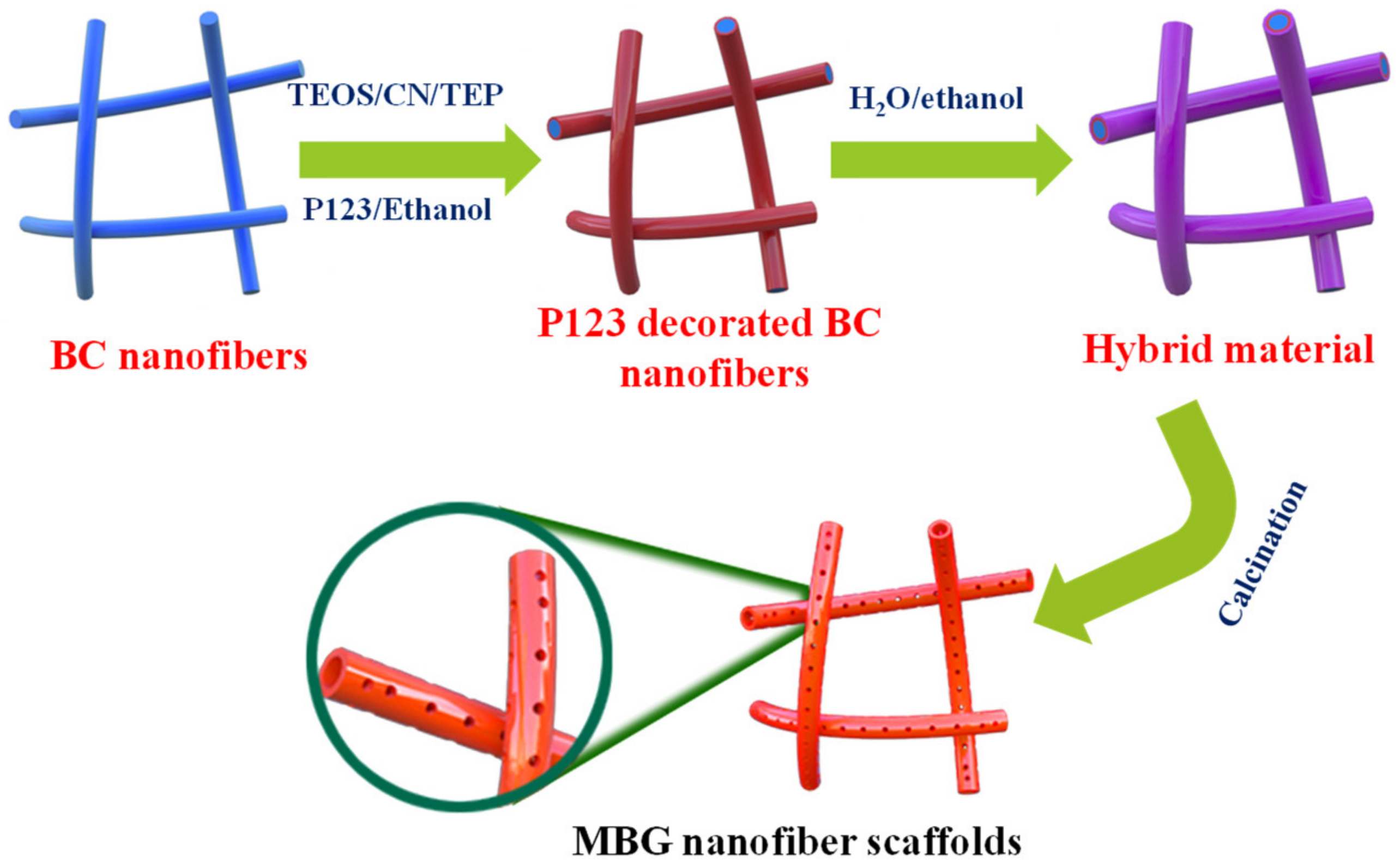
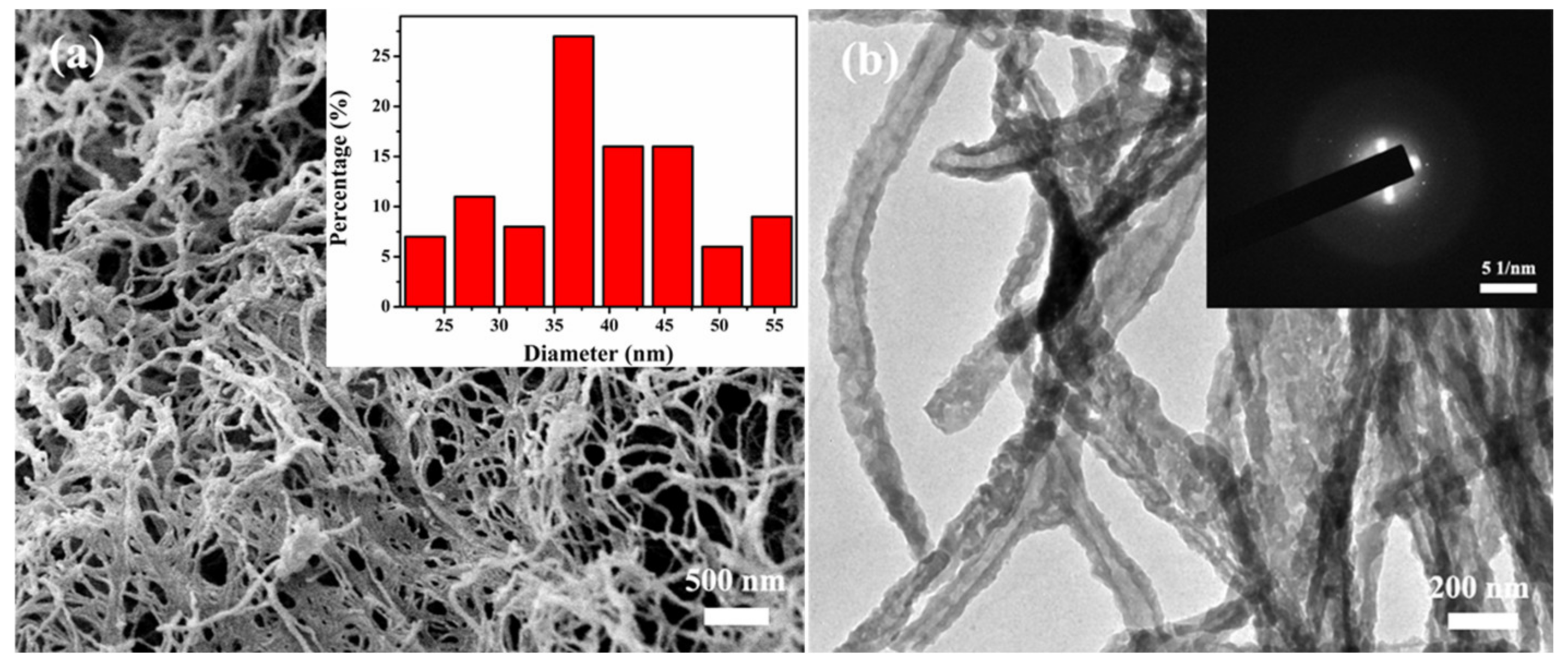
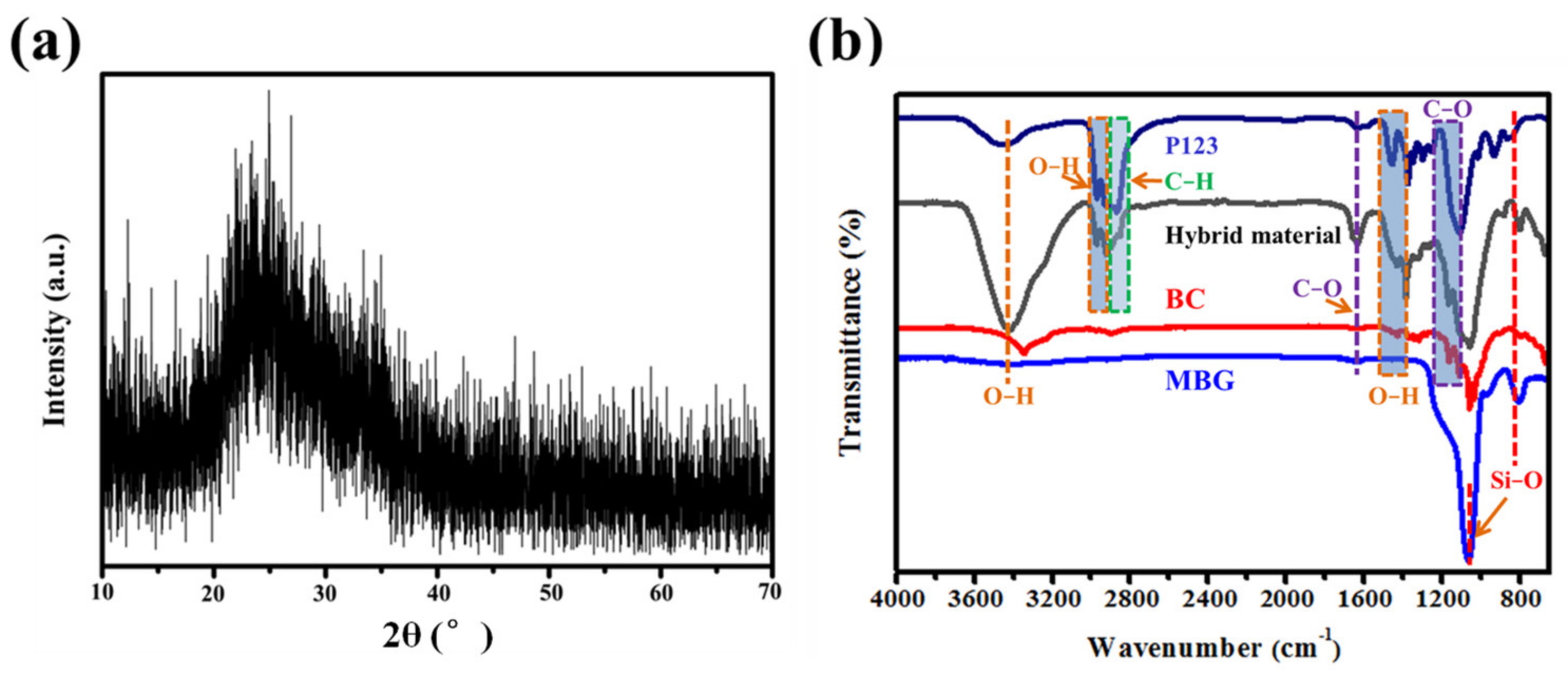

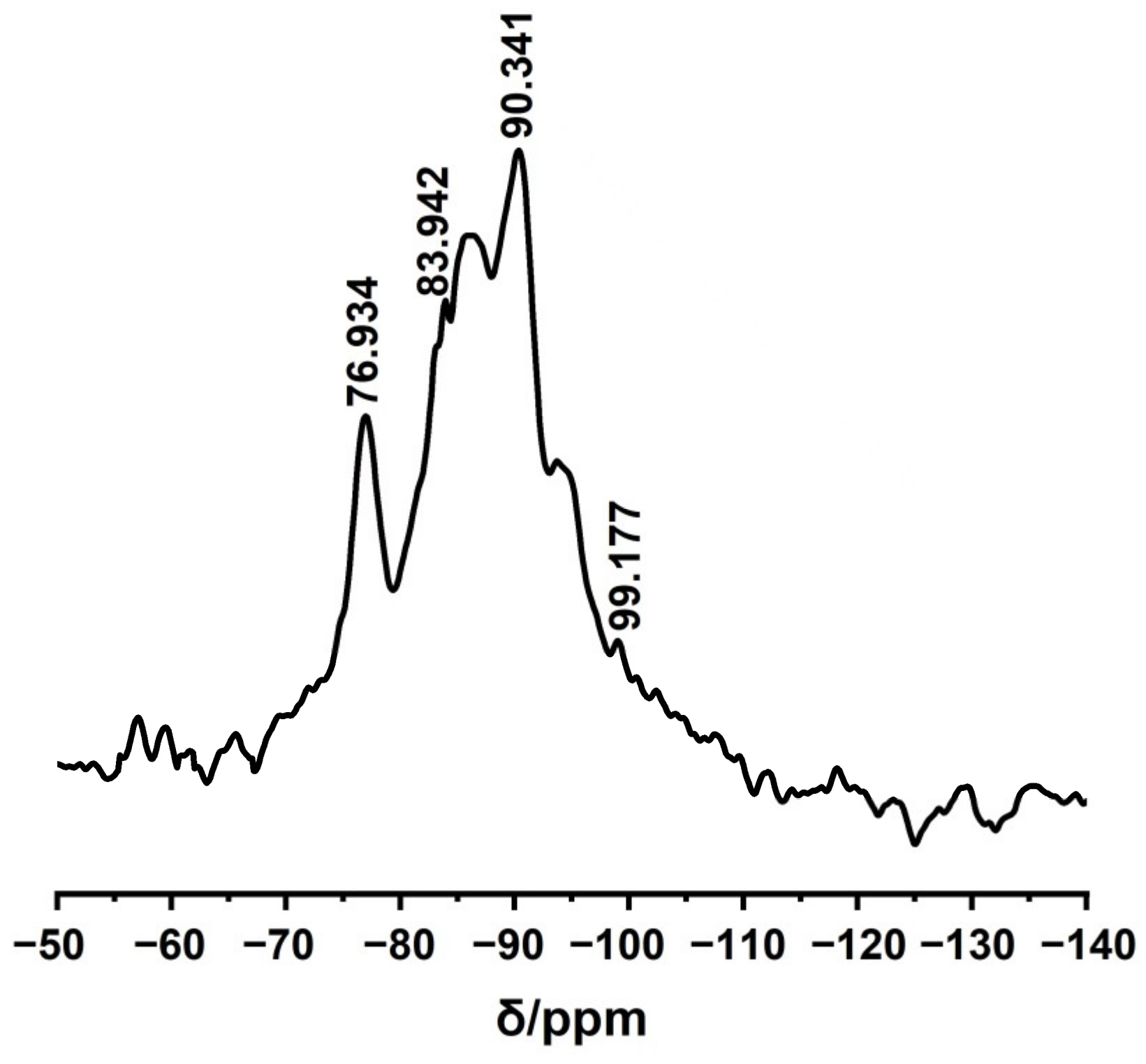


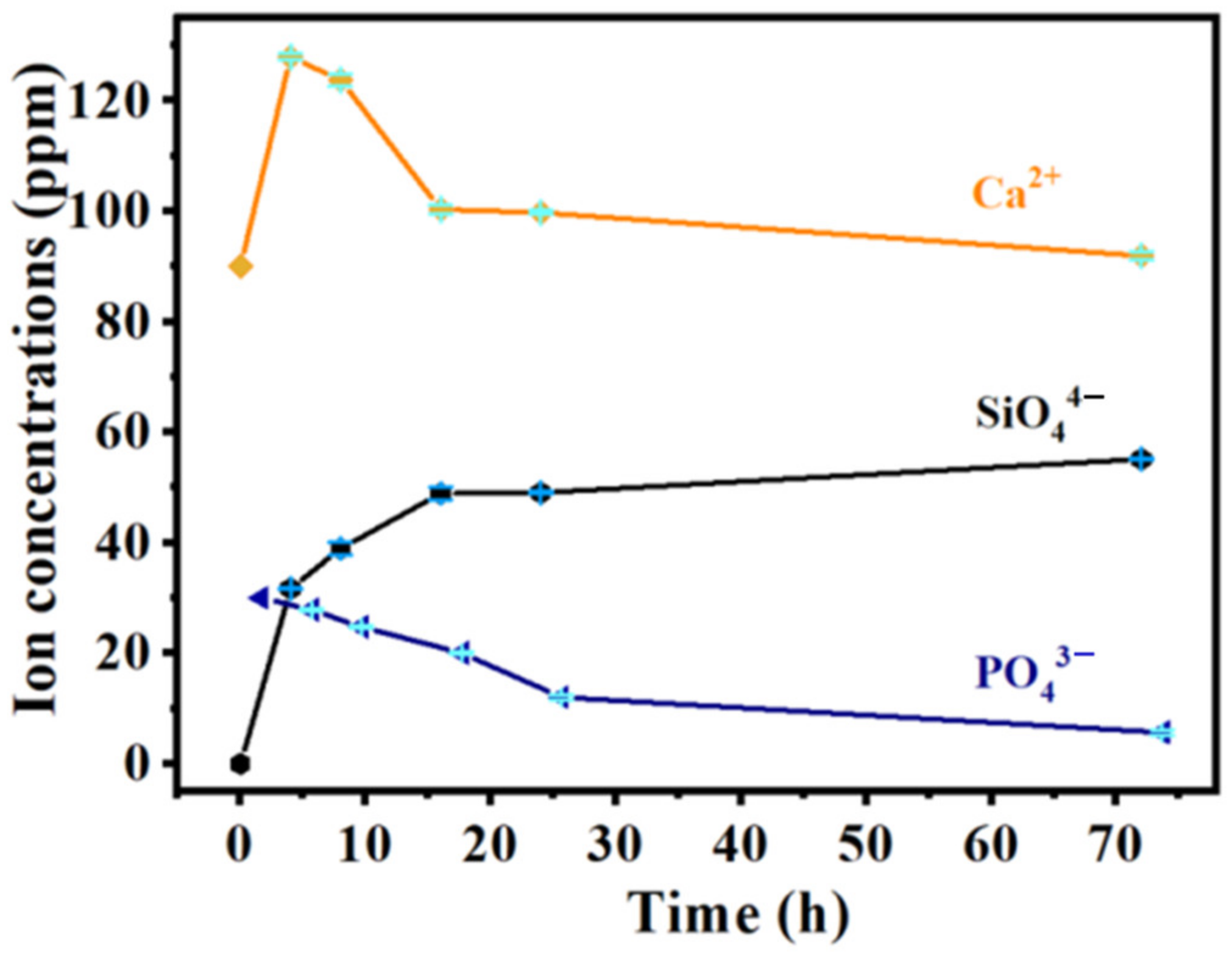

| Samples | Specific Surface Area (m2 g−1) | Pore Volume (cm3 g−1) | Pore Size (nm) |
|---|---|---|---|
| MBG | 230.0 | 0.2 | 22.0 |
Publisher’s Note: MDPI stays neutral with regard to jurisdictional claims in published maps and institutional affiliations. |
© 2022 by the authors. Licensee MDPI, Basel, Switzerland. This article is an open access article distributed under the terms and conditions of the Creative Commons Attribution (CC BY) license (https://creativecommons.org/licenses/by/4.0/).
Share and Cite
Xiao, J.; Wei, Q.; Xue, J.; Yang, Z.; Deng, Z.; Zhao, F. Preparation and In Vitro Bioactivity Study of a Novel Hollow Mesoporous Bioactive Glass Nanofiber Scaffold. Molecules 2022, 27, 7973. https://doi.org/10.3390/molecules27227973
Xiao J, Wei Q, Xue J, Yang Z, Deng Z, Zhao F. Preparation and In Vitro Bioactivity Study of a Novel Hollow Mesoporous Bioactive Glass Nanofiber Scaffold. Molecules. 2022; 27(22):7973. https://doi.org/10.3390/molecules27227973
Chicago/Turabian StyleXiao, Jian, Qianghua Wei, Jinhong Xue, Zide Yang, Zhicheng Deng, and Fulai Zhao. 2022. "Preparation and In Vitro Bioactivity Study of a Novel Hollow Mesoporous Bioactive Glass Nanofiber Scaffold" Molecules 27, no. 22: 7973. https://doi.org/10.3390/molecules27227973
APA StyleXiao, J., Wei, Q., Xue, J., Yang, Z., Deng, Z., & Zhao, F. (2022). Preparation and In Vitro Bioactivity Study of a Novel Hollow Mesoporous Bioactive Glass Nanofiber Scaffold. Molecules, 27(22), 7973. https://doi.org/10.3390/molecules27227973







